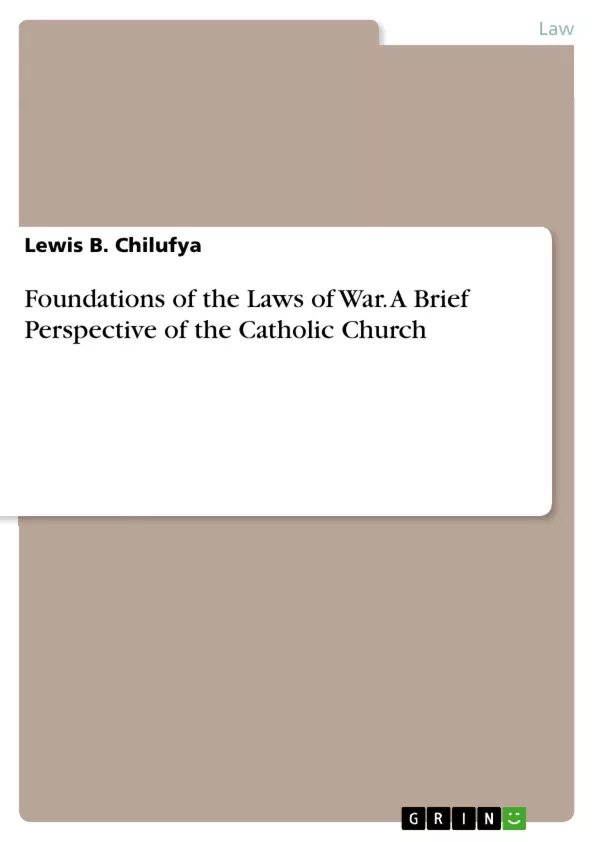This book illustrates that the international laws of war are founded on natural law as conceived in the Catholic Church's Moral Theology. In particular, it treats of the jus ad bellum strand of the international law as contained in the United Nations Charter. This aspect of international law spells out conditions for the legality of resort to interstate armed conflict or war.
The second strand of international law, which this book addresses, is the jus in bello which deals with the right conduct and method of war. With this background, the book then explicates the nature and constituents of natural law from the standpoint of Catholic Moral Theology.
The final part of the book then makes an analysis of the two forms of international law in the light of the understanding of natural law. In this way, it demonstrates that the source of the international regulations concerning recourse to use of armed force in interstate conflicts is actually the values contained in the natural law theory as understood by the Catholic Church.
Inhaltsverzeichnis (Table of Contents)
- GENERAL INTRODUCTION
- CHAPTER ONE
- THE INTERNATIONAL LAW AND WAR
- 1.0 Backdrop on the International Law.
- 1.1 Towards a definition of the International Law
- 1.2 The objective of the International Law.
- 1.3 Basic Principles of the International Law.
- 1.4 Sources of the International Law.
- 2.0 The Concept of War.
- CHAPTER TWO
- THE INTERNATIONAL LAW OF WAR
- 2.1 THE INTERNATIONAL RULES OF WAR.
- 2.1.1 The Prohibition of the Threat and Use of Force.
- 2.1.2 The Right of Self-Defense
- 2.1.3 Instantiation of War vis-à-vis the Laws of War
- 2.2 THE INTERNATIONAL HUMANITARIAN LAW
- 2.2.1 Historical Development of the Humanitarian Law.
- 2.2.2 Nature of the International Humanitarian Law.
- 2.2.3 Application of the International Humanitarian Law.
- CHAPTER THREE
- NATURAL LAW AND THE INTERNATION LAWS OF WAR
- 3.1 THE THEORY OF NATURAL LAW
- 3.1.1. Formulation of the Doctrine of Natural Law
- 3.1.2 The Essential Constituents of Natural Law.
- 3.1.3. The Contents of Natural Law
- 3.1.4. The Characteristics of the Natural Law.
- 3.1.5. Knowledge of the Natural Law
- 3. 2 NATURAL LAW VIS-À-VIS THE INTERATIONAL LAWS OF WAR AND THE HUMANITARIAN LAW
- 3.2.1. The General Arguments.
- 3.2.2 The Specific Arguments.
Zielsetzung und Themenschwerpunkte (Objectives and Key Themes)
This book aims to explore the foundational principles of the International Law of War from a Catholic perspective. It delves into the historical development, nature, and application of both international law and humanitarian law, and examines the intersection between these legal frameworks and the theory of natural law.
- The historical and philosophical development of international law and its application to armed conflict
- The relationship between international law, humanitarian law, and the Catholic Church's teachings
- The role of natural law in shaping ethical considerations regarding war and peace
- The concept of just war theory and its relevance in contemporary international law
- The importance of protecting human dignity and rights in the context of armed conflict
Zusammenfassung der Kapitel (Chapter Summaries)
Chapter one introduces the international law and war. This chapter explores the development, objectives, basic principles, and sources of international law. It also delves into the concept of war as a social phenomenon and its implications under international law. Chapter two examines the international law of war, focusing on the prohibition of the threat and use of force, the right of self-defense, and the instantiation of war vis-à-vis the laws of war. It also delves into the historical development, nature, and application of international humanitarian law. Chapter three explores the theory of natural law and its relationship to international law of war and humanitarian law. It investigates the formulation, essential constituents, contents, characteristics, and knowledge of natural law, examining the general and specific arguments for its application in the context of armed conflict.
Schlüsselwörter (Keywords)
The main keywords and focus topics of this work include international law, international law of war, humanitarian law, natural law, just war theory, human rights, armed conflict, Catholic Church, and ethics of war.
- Quote paper
- Lewis B. Chilufya (Author), 2005, Foundations of the Laws of War. A Brief Perspective of the Catholic Church, Munich, GRIN Verlag, https://www.grin.com/document/387178



